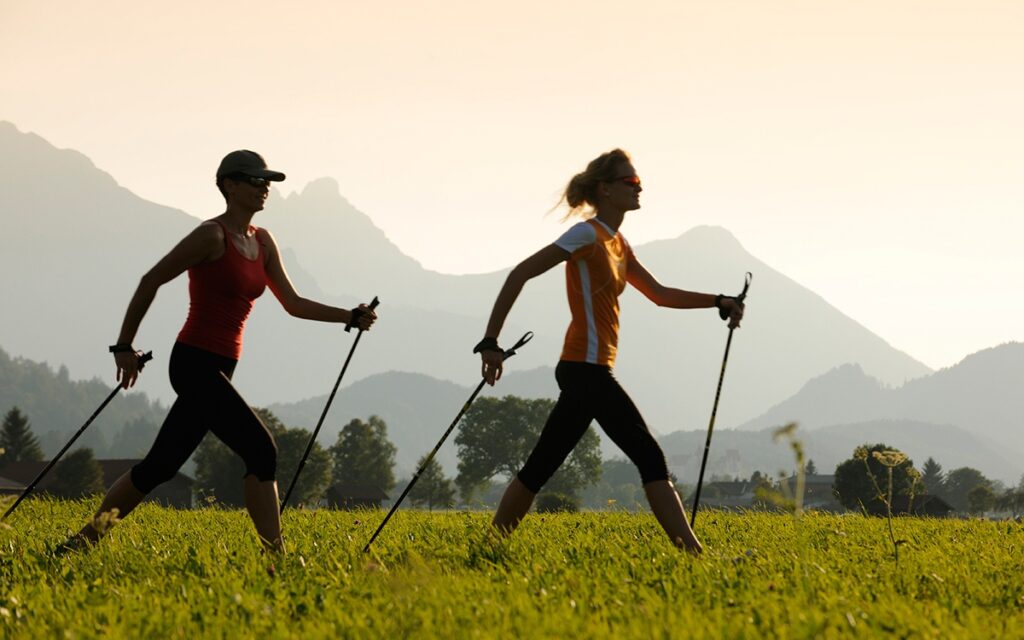Benefits of Nordic Walking: Improve Your Health and Fitness Outdoor
06 March 2024

As summer approaches, it’s the perfect time to embrace the outdoors and stay active. Engaging in outdoor activities during the warmer months is essential for lifting your mood, maintaining physical health, and enjoying the sunshine. Our friends at Bristol Nordic Walking have been leading the way with their energising, mood-boosting form of exercise: Nordic walking.
What is Nordic Walking?
Nordic walking is based on your natural walking pattern but incorporates two specially designed poles angled backwards to enhance upper body strength and accelerate your forward movement. These poles, distinct from trekking poles, have glove-type straps that clip into ergonomic handles, allowing for a full arm swing and greater power, engaging your whole body.
The Benefits of Nordic Walking
1. Core Strength
Nordic walking is like pilates in motion. Each time you push the pole into the ground, you engage your deep core stabilising muscles, which support your balance and back.
2. Back Health
The gentle rotation of your spine during Nordic walking strengthens the muscles supporting your spine, enhancing overall back health.
3. Immune System
Walking outdoors, especially during summer, invigorates your body and mind, potentially boosting your immune system by keeping you away from indoor environments.
4. Improved Posture
Nordic walking teaches you how to walk with good posture, including lengthening your spine, maintaining the correct head position, lifting your chest, distributing your weight evenly, and using your feet properly.
5. Heart Health
As a full-body exercise, Nordic walking uses almost all of the body’s skeletal muscles, making your heart and lungs work harder. This helps lower blood pressure, reduce the risk of heart disease and type 2 diabetes, and keep your arteries clear.
6. Strong Bones
Public Health England recommends Nordic walking as a muscle and bone strengthening activity. The weight-bearing nature and resistance provided by the poles improve bone health and strength.
7. Mental Health
Exercise reduces stress and anxiety, and being outdoors in green surroundings amplifies these benefits, improving mental health and overall well-being.
8. Fun and Sociable
Nordic walking is enjoyable and sociable. It gets you outdoors, helps you explore your local area, and is non-competitive, making it accessible to everyone, regardless of their fitness level.
Getting Started with Nordic Walking
To get the most out of Nordic walking, learning the correct technique from a qualified instructor is crucial. Bristol and Bath have one of the largest Nordic walking centres in the UK, making it easy to find an instructor and classes that suit you.
Vicky Welsh’s Expertise
Our very own patient, Vicky Welsh, who wrote the book “Let’s Walk Nordic,” offers comprehensive guidance on Nordic walking. Her book, videos, and workshops provide valuable tips and techniques to help you maximise the benefits of this exercise.
Workshops and Events
- Learn Nordic Walking in 10 Simple Steps: Saturday 8th June 10.30-12.30
- Mastering Nordic Walking: Technique Enhancement Workshop: Saturday 25th May 2024, 10.30am -12noon; Thursday 30th May 2024, 10-11.30am
Nordic Walking Weekend
Join Vicky for a Nordic walking weekend in the beautiful Surrey Hills on 11-12 October 2024. This event includes scenic walks, visits to historical sites, and delicious meals, all while enhancing your Nordic walking skills.
Team Building Workshops
Nordic walking is an excellent activity for team-building, providing a fun, social way to improve physical and mental health. These workshops are non-competitive and suitable for all fitness levels.
Nordic walking is an all-gain, no-pain way to improve your health, fitness, and well-being. Whether you’re new to this exercise or looking to enhance your technique, Nordic walking offers numerous benefits while allowing you to enjoy the outdoors.
Ready to experience the benefits of Nordic walking? Start your journey towards better health and fitness today. Contact us to learn more about our guided walks, workshops, and how to get started. Let’s walk towards a healthier, more active lifestyle together.
